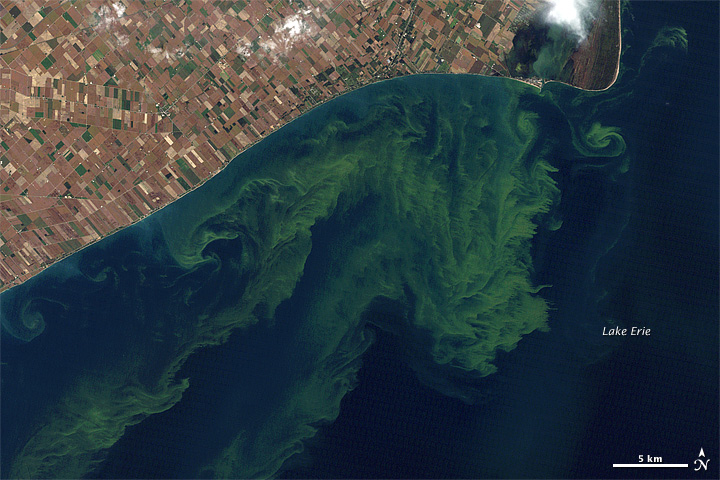Harmful Algal Blooms and Nutrient Dynamics
HABs have been a focus of Ohio Sea Grant's work since 1971. Today, Sea Grant's work on reducing and preventing HABs ranges from the local to the international level
During the event, Ohio Sea Grant director Dr. Jeff Reutter and research coordinator Dr. Justin Chaffin were on the phone with the U.S. and Ohio Environmental Protection Agencies (EPA) as well as city officials from Toledo to help inform their management of the issue.
But August 2014 was far from the first time Ohio Sea Grant worked on the front lines to restore the health of Lake Erie. Nutrient loading, algal blooms and the dead zone – an area of low oxygen that develops in the central basin during the summer – have been an important part of Ohio Sea Grant’s work since 1971 when the Center for Lake Erie Area Research (CLEAR) was formed.

View more at earthobservatory.nasa.gov
“Our efforts to bring Lake Erie back from its dead lake image to becoming the walleye capital of the world were a success,” remembers Reutter. “However, once decision makers felt that there was no longer an acute problem, funding and monitoring for further research were diverted to other focus areas.
That change in priorities has come back to haunt Lake Erie again in the past two decades. Steadily increasing concentrations of phosphorus – a vital nutrient for agriculture crops that also fuels harmful algal blooms in the lake – have resulted in an increase in the occurrence and severity of algal blooms. The western basin, which receives runoff from the Maumee River watershed, the largest agricultural watershed feeding into the Great Lakes, is especially affected by phosphorus levels that have returned to what they were during the height of the problem in the 1970s.
While funding from the U.S. EPA for water quality monitoring ended in the mid-80s, students at Stone Lab continued to conduct an informal monitoring effort, and Ohio Sea Grant and Stone Lab began to prepare for the current situation in the mid-90s.
CURRENT
Projects
CURRENT PROJECTS
Enhancing nutrient removal from agricultural tile drainage by understanding the role of organic carbon quality
RECORD:
R/ES-026-PDPrincipal Investigator:
Angelica Vazquez-Ortega, Assistant Professor of Geochemistry, Bowling Green State University
Institution:
Bowling Green State University
Research in progress.
Curriculum Development for Watershed Nutrient Testing using DIY Spectroscopy
RECORD:
E/CD-003-PDPrincipal Investigator:
Kelly Siman, Biomimicry Fellow, University of Akron Biology Department
Institution:
Research in progress.
Hindcasting cyanobacterial harmful algal bloom timing and extent in western Lake Erie using lake surface temperature variability
RECORD:
R/ER-135-LEPFPrincipal Investigator:
Timothy Davis, Professor, BGSU Department of Biological Sciences
Institution:
Bowling Green State University
Research in progress.
Evaluating nutrient retention and removal associated with ditch management and restoration and exploring the role of biota
RECORD:
R/ER-134-LEPFPrincipal Investigator:
Kevin McCluney, Assistant Professor, BGSU Department of Biological Sciences
Institution:
Bowling Green State University
Research in progress.
Nutrient Biogeochemistry Consequences of Beneficial Re-use of Dredge Material (Sandusky Bay)
RECORD:
R/ER-133-LEPFPrincipal Investigator:
Lauren Kinsman-Costello, Assistant Professor, Kent State Department of Biological Sciences
Institution:
Research in progress.
Lake Erie Open Water HAB Impairment Criteria
RECORD:
R/HAB-013-ODHEPrincipal Investigator:
Thomas Bridgeman, Professor & Director, UT Lake Erie Center
Institution:
Research in progress.
Evaluation of the effects of changing on-farm manure management practices on reduction of dissolved phosphorus runoff
RECORD:
R/HAB-014-ODHEPrincipal Investigator:
Harold Keener, Associate Chair, OSU Department of Food, Agricultural and Biological Engineering
Institution:
Research in progress.
Spatial Distribution Model for Manure from Permitted Livestock Facilities (CAFOs/CAFFs) in the Lake Erie Western Basin and Maumee Watershed, Ohio
RECORD:
R/HAB-016-ODHEPrincipal Investigator:
Patrick Lawrence, Associate Dean, UT College of Arts and Letters
Institution:
Research in progress.
Tracking and Attenuating Nutrient Loads from Manure Fertilization
RECORD:
R/HAB-017-ODHEPrincipal Investigator:
William Midden, Associate Vice Provost for Experiential and Innovative Learning, Bowling Green State University
Institution:
Bowling Green State University
Research in progress.
Testing and Optimization of Microcystin Detoxifying Water Biofilters
RECORD:
R/SDW-010-ODHEPrincipal Investigator:
Jason Huntley, Laboratory Director, UT Department of Medical Microbiology and Immunology
Institution:
Research in progress.
 OHSU-FS-1040 10 things I should know about algal blooms
OHSU-FS-1040 10 things I should know about algal blooms  OHSU-FS-911 Harmful Algal Blooms in Ohio Waters
OHSU-FS-911 Harmful Algal Blooms in Ohio Waters